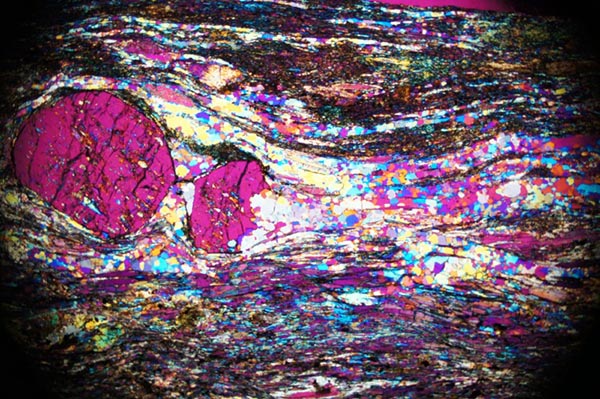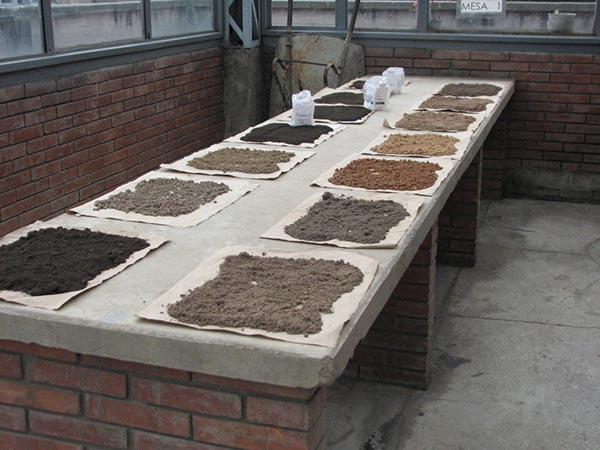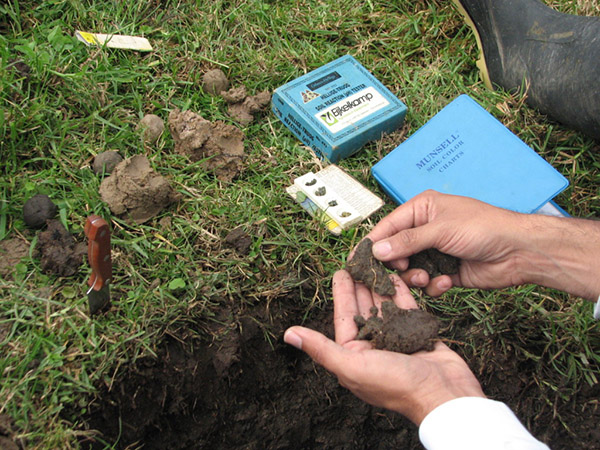
Thin section of soil viewed under a petrographic microscope. Licensed under Creative Commons.
Optical mineralogy is a gaze turned deeply earthward into seeming dark, still, and silent depths. Indeed, when I first peered into a petrographic microscope in the Soil Science Laboratory of Colombia’s National Geographic Institute Agustín Codazzi (IGAC), I was slightly disappointed to find myself staring at what appeared to be an unassuming slice of magnified dirt.[1]
As soon as the polarizer filter was slipped into place, however, uniform darkness exploded into a kaleidoscope of fuchsias, yellows, violets, and blues. Odd shapes took form, mutated, and then disappeared as though enveloped back into a slowly churning color wheel. Hues shifted in intensity from shades of light to dark, more radiant and increasingly dull as the light diffracted mineral particles and the voids between them at different angles. The IGAC mineralogist who invited me to his workbench that morning registered my surprise, and reminded me that this was only the color spectrum detectable to the human eye. He went on to measure miniscule quartz grains and the size of clay minerals, and to note plant fragments and channels that indicate good oxygen flow and porosity. For me, this moment was akin to what renowned geographer and soil scientist, Francis D. Hole, described as the aesthetic “pleasures of soil watching.”[2] For the mineralogist, his observations were important because they could alert to early signs of soil degradation or other ongoing structural damage caused by climatic forces that are increasingly difficult to disentangle from histories of human use and abuse.
If modern geology tells planetary stories through cycles of rocks, and archaeology stories of human activity through an analysis of material culture, then soil mineralogy can be said to diffract the granular stories of human-soil co-substantiation. When we peer through a petrographic microscope we are viewing particles that have registered the vibrational motion of water molecules, films, and air deposited by wind and rainfall, and compressed by tractor tires and countless cattle hooves. We inhale with a body that has respired over and over again, often exhausted by the intensity of industrialized agriculture and left gasping for breath. We are invited to descend into the laggard times of weathering bedrock and the leaching of one soil horizon into the next. We delve with roots and sprout with tree seedlings as they strive to become a regrowth forest. Clinging to legume nodules until we can cling no more, we are shaken loose from the tips of rootlets during a harvest. We are graced by the light touch of fallen leaves as they curl up and decompose into mulch that enfolds back into our depths. Pierced open and sucked dry by oil wells, we have absorbed layered histories of territorial appropriation, dispossession, and extractive-based modes of death. We have been converted into property and demarcated by fences, and now find ourselves sealed under the asphalts of urban growth. We harbor microbial remains that have been rolled over by military tanks, displaced by synthetic fertilizers, and metabolized into colloidal slime that lines the tunnels of burrowing worms.

“Soil samples” drying on the rooftop of the IGAC (National Geographic Institute Agustín Codazzi) before they travel to the chemistry, physics, and mineralogy divisions of the National Soil Science Laboratory for analysis. Image by author.
At the interface of anthropology and feminist science studies, my research focuses on ecological practices with regards to the sciences, technologies, and politics of human-soil relations in Colombia. In particular, the struggles and potential collaborations between rural communities, state officials, aid workers, armed actors, and scientists over the meanings of “peace,” “productivity,” “rural development,” “sustainability,” “autonomy,” and what constitutes a “good life.” Soils defy modern dualisms between ‘nature’ and ‘culture’ and ‘bio’ and ‘geo’ (living organisms and non-living matter). Inasmuch, they also trouble modern temporal divides between ‘past’, ‘present’ and ‘future.’ There is no final material erasure of the past in the sedimented fabrics of their recycling bodies.
Co-laborer and host to all terrestrial experiments and tragedies, life-sustainer, evolving body, grave, and trash dump, soils seem almost too resilient and hospitable for their own good. I am reminded of feminist philosopher Rosalyn Diprose’s (2002) writings on the unequal distribution and selective forgetting of corporeal generosity. Systematic forgetting results from the asymmetric evaluation of different bodies and the kinds of labor, benefits, and relations they enable.[3]
How might we work against the selective forgetting of not only the soils’ labor and generosity—much of which is extracted by force—but its corporeal existence, limits, and rights to flourish? In a 1984 interview the soil scientist Hans Jenny said, “if you are used to thinking of soil as dirt, which is customary in our society, you are not keyed to find beauty in it”(158).[4] Just plain dirt has often left soils appearing just plain dead. Both Jenny and Hole spent much of their careers inviting scientists and citizens to turn their attention to material substance and affective sensation, corporeal generosity and its poetic coalescence in order to transform the soil’s anonymity in popular imagination, and the extractivism characterizing modern human-soil relations.

IGAC scientists begin a classification process using a Munsell color chart, which translates levels of soil moisture, during a soil survey in Fusagasugá, Cundinamarca. Image by author.
Over the last decade, the concept of soil health has emerged as an alternative among scientists, international agricultural development agencies, and resource-management communities to unsettle dominant perceptions of soil as simply an economic growth medium for crops. The rise of modern soil science itself was closely correlated to the demand for increased soil fertility to support capitalist agriculture in Europe and North America, guano imperialism, the introduction of synthetic fertilizers, and more recently the global expansion of the Green Revolution’s emphasis on “improved” seeds and agri-chemical input substitution.
The acknowledgment that a soil has its own requirements for and rights to integral care, wellbeing, and sustainable present(s)-future(s) is an important shift that forefronts soils as living beings with corporeal capacities and limits. Nevertheless, a commitment to work against the selective forgetting of soils’ corporeal generosity requires that health-oriented discourses be informed by the protracted violence of coloniality, exhaustive plantation systems, capitalist accumulation, neoextractive logics, and ongoing struggles for socio-ecological justice. Many rural communities in Colombia and beyond say that when a horrible event occurs in a place, the soils, trees, and other elements, and beings hold that violence.

This piece by Katie Scott, commissioned for the NY Times, is an example of current artistic imaginings of soil biology or the hidden world of soil beneath our feet.
We not only observe the size and integrity of sand, silt, and clay particles through the prism of a petrographic microscope, but we are also ushered into permeable voids, and the transformations of life, death, energy, and matter that flow through and are hauntingly absorbed by a porous body. Rather than pit technoscientific modes of detecting soil health against poetic forms of embodiment, how might both sets of practices aid and oblige us to address the historically uneven global distribution of soil degradation and shared experiences of human and non-human dispossession?
Endnotes
[1] Optical mineralogy is the study of geological materials by measuring their optical properties in order to help reveal their origin and evolution. Most commonly, soil samples are prepared as thin sections for study in the laboratory with a petrographic microscope. The principal difference between a petrographic and a biological microscope is the presence of two polarizing elements, one above and one below the stage.
[2] Francis D. Hole. 1988. “The Pleasures of Soil Watching,” Orion Nature Quarterly Spring 6-11.
[3] Rosalyn Diprose. 2002. Corporeal Generosity: On Giving with Nietzsche, Merleau-Ponty, and Levinas. New York: State University of New York Press.
[4] Hans Jenny. 1984. “My friend the soil: A conversation with Hans Jenny”, Journal of Soil and Water Conservation May-June: 158-161.
